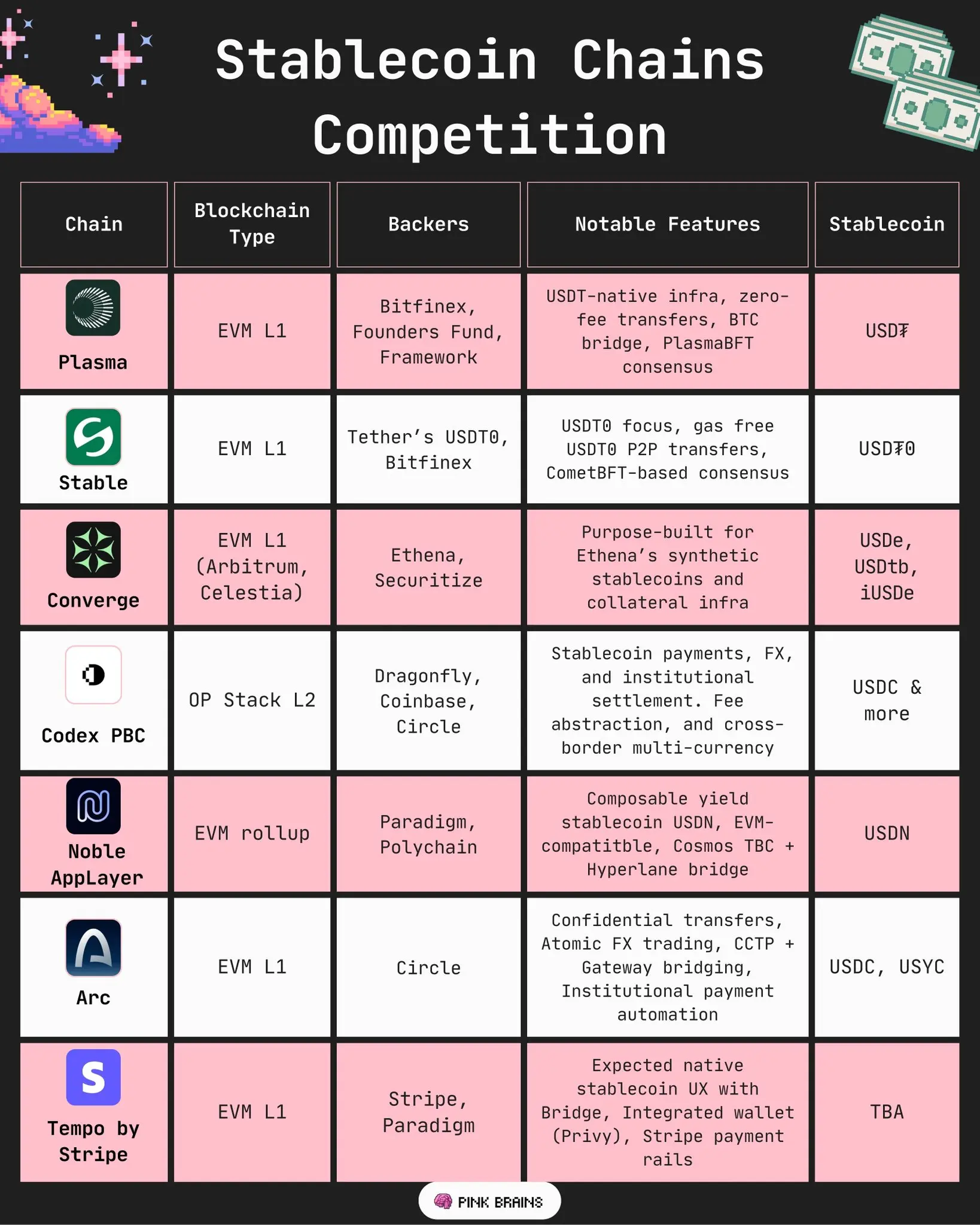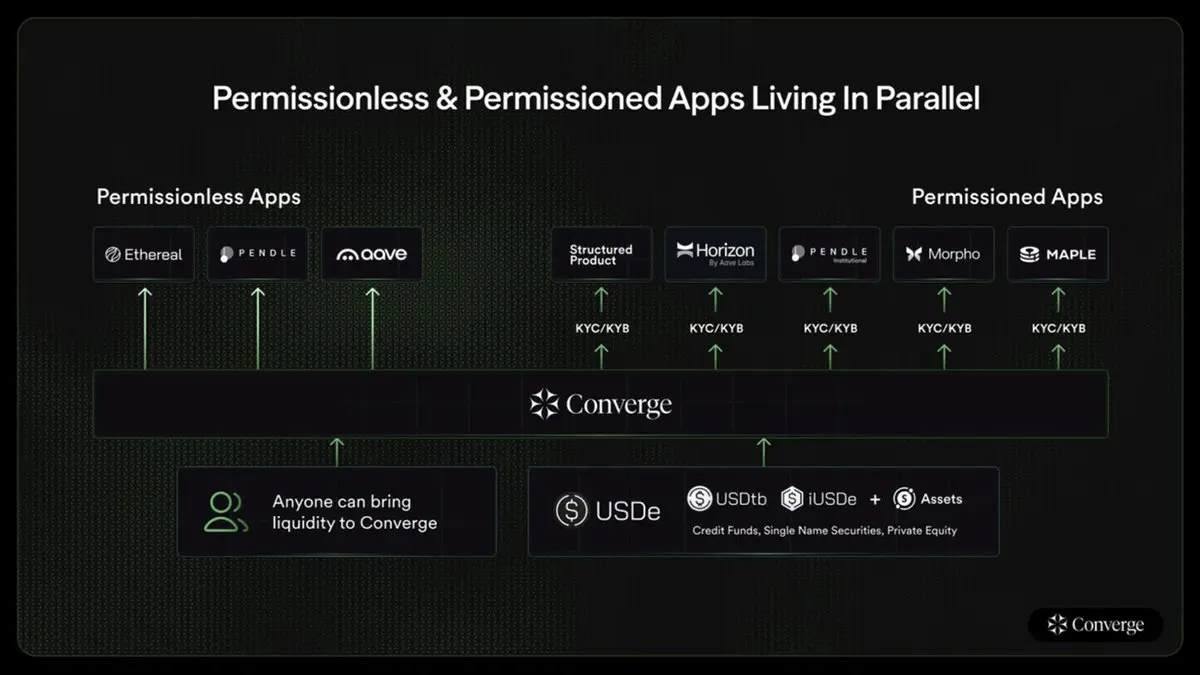Author: Pink Brains, DeFi Analysis Platform; Compiler: Yuliya, PaNews
The current competitive landscape in the cryptocurrency space is shifting. The focus is no longer on the war between Layer 2 blockchains; a new battlefield has emerged: stablecoin chains. Companies like Tether, Circle, and Stripe are launching dedicated blockchains designed to serve global stablecoin payments.
Why are new dedicated chains needed?
Some may ask, since public chains like Ethereum, Solana, and Tron already exist and perform well, why build a new blockchain? The answer is that these existing public chains are not designed for the following specific requirements:
Massive transaction volume and low latency: supporting millions of transactions per day with millisecond latency. Predictable, low-cost fees: Transaction fees are denominated in the stablecoin itself and are predictable. Built-in fiat on- and off-ramps: Natively integrate fiat-to-cryptocurrency exchange functionality. Compliance-friendly privacy: Provides privacy protections that meet regulatory requirements. Customizable control over infrastructure and economic models: Allows projects to customize the underlying architecture and economic incentives. We are witnessing a shift from general-purpose blockchains to specialized, niche chains. These new "vertical chains" are end-to-end optimized for payments, settlements, and scalable applications. Below is a detailed introduction to seven major stablecoin native chains, including their builders, working principles, and development directions.

Plasma
Plasma is a sidechain secured by Bitcoin and compatible with EVM, focusing on optimizing USDT transfers. Core Technology: Utilizes the PlasmaBFT consensus mechanism, a pipelined, parallelized variant of the Fast HotStuff protocol designed for faster transaction finality and high throughput. Fee Model: Provides zero-fee USD₮ transfers, supports custom gas tokens, and offers optional confidential payment functionality. Plasma is fully EVM-compatible. Integrations: Complete stablecoin infrastructure is built-in, including card issuance, fiat-to-cryptocurrency conversion channels, risk management tools, and private payment capabilities. Native Bridge: A native, trust-minimized BTC bridge supports direct interaction between BTC and EVM assets. Existing partnerships include: Yellow Card (enabling USDT remittances in Africa via Plasma), BiLira Kripto (providing a compliant Turkish Lira-USDT exchange channel in Turkey), Uranium Digital (enabling 24/7 on-chain uranium settlement), Axis (launching xyUSD, an interest-bearing stablecoin backed by hedge fund strategies), and Curve Finance (planning to support deep and efficient stablecoin swaps). Other well-known multi-chain DeFi protocols such as Aave, Pendle, and Ethena are also planning to integrate.
In terms of financing, Plasma has received support from Founders Fund, Framework Ventures and Bitfinex, raising $24 million in the latest round of financing. Its public token sale attracted $373 million in subscription intentions and sold out within 30 minutes. Its test network is now online and the main network is about to be launched.
Stable
Stable is a new, EVM-compatible Layer 1 blockchain jointly developed by Bitfinex and Tether. Stable aims to eliminate almost all friction when transferring USDT on a large scale. Core Technology: It runs on StableBFT consensus, a CometBFT proof-of-stake mechanism designed for high-load stablecoin operations, offering low latency and high throughput. Through optimistic parallel execution, it aims to achieve speeds of up to 10,000 transactions per second (TPS). Fee Model: Its native gas token is gasUSDT, but thanks to account abstraction technology, users can pay transaction fees directly with USDT0. Peer-to-peer USDT0 transfers are gas-free, and holders can achieve gas-free transactions through LayerZero relays. Ecosystem Integration: Its roadmap includes built-in fiat on- and off-ramps, debit card integration, and enterprise-grade "fast lanes," aiming to combine the speed of on-chain funds with a smooth, Web2-like user experience. In terms of funding, the project raised $28 million in a seed round led by Bitfinex and Hack VC, with participation from Franklin Templeton, Castle Island, and USDT0. Currently, Stable is in a private testnet phase and expects to launch a public testnet later this year. Converge is an Ethereum Layer 2 network built on Arbitrum technology, jointly developed by Ethena Labs and Securitize. Core Technology: The execution layer uses Arbitrum, with data availability provided by Celestia. It utilizes a custom G2 sorter powered by Conduit, with a block time target of 100 milliseconds and plans to achieve GigaGas+ throughput. Fee Model: Gas fees are paid in $USDe and $USDtb. Security and Validation: Nodes validate transactions by staking $ENA in the Converge validator network. Through the provision of custodial security by institutions such as Anchorage, Fireblocks, Zodia, and Copper, institutional users have increased operational comfort.
Existing collaborations: Hamilton Lane (bringing tokenized private credit and equity funds), Morpho Labs, Pendle, Maple Finance, Horizon and other institutional-oriented permissioned applications, as well as native applications centered around sUSDe and real returns (such as Strata, Terminal, Ethereal, Aave, etc.).

Codex
Codex is a secure, high-throughput Ethereum L2. Codex is aimed at enterprises that need to use stablecoins in real financial processes (payroll, finance, trade) and value compliance, predictability and privacy. It is designed for stablecoin native payments, foreign exchange and settlements. Core Technology: Built on OP Stack and hosted by Conduit. Fee Model: Transaction fees and gas abstraction are optimized for stablecoin flows, while deterministic execution ensures institutional-grade reliability. Built-in Features: Built-in foreign exchange and custody capabilities support multi-currency settlement. Furthermore, the solution relies on the Ethereum mainnet for final settlement, ensuring security and finality.
In terms of financing, Codex raised $15.8 million in a seed round led by Dragonfly, with support from Circle Ventures, Coinbase, Cumberland, and Wintermute. Its mainnet was launched in mid-2024.
Noble
Noble was originally a native asset issuance chain for the Cosmos ecosystem, designed to introduce USDC and other stablecoins to application chains connected to IBC (Inter-Blockchain Communication Protocol). To date, Noble has processed over $8 billion in trading volume, supporting the flow of stablecoins on dYdX and other Cosmos application chains. To address programmability limitations, Noble is launching an EVM-compatible rollup, called Noble AppLayer, secured by Celestia, offering 100-millisecond block times and composable stablecoin yields on USDN (Noble's own stablecoin). It also supports providing liquidity to EVM chains via Hyperlane/IBC and provides a gateway to Noble's issuance services for EVM chains. It is fully compatible with the Cosmos ecosystem, making it easier for developers to create stablecoin-based applications and expand to more blockchain networks. In terms of financing, Noble completed a $15 million Series A funding round last year, led by Paradigm. The Noble AppLayer is expected to launch this summer. Circle announced the launch of Arc, a blockchain designed specifically for stablecoin finance. The chain aims to connect traditional finance with stablecoin native chains and support internet-scale applications. The Arc chain boasts a processing capacity of approximately 3,000 TPS, with final transaction confirmation times of less than 350 milliseconds, and is supported by 20 validators. Fee Model: USDC is the native gas token, and the interest-bearing stablecoin USYC is supported. Built-in Features: Arc features a built-in foreign exchange (FX) engine, enabling on-chain inter-institutional FX swaps through a request for quote (RFQ) mechanism. It also offers selective privacy, enabling confidential transfers by viewing private keys. To address the Maximum Extractable Value (MEV) issue, Arc has developed a mitigation roadmap that includes encrypted trading pools, transaction batching, and a multi-proposer mechanism. Arc aims to connect traditional finance (TradFi) and stablecoin native chains at internet scale. It is tightly integrated with Circle's infrastructure, natively supports CCTP and Gateway cross-chain transactions, provides chain-abstracted balance management, and offers businesses tools such as on-chain invoicing, refunds, and AI-powered financial management. While not pursuing maximum decentralization, Arc aims to embed tokenized USD into enterprise payments, foreign exchange, and financial processes. Arc will launch a private testnet in the coming weeks and a public testnet this fall. It will support USDC as its core, but will also be open to other digital dollars and tokenized assets. Tempo is a stablecoin blockchain jointly developed by payments giant Stripe and renowned crypto VC Paradigm. Focused on payments and compatible with Ethereum, Tempo is led by Paradigm co-founder Matt Huang as CEO. Tempo does not utilize a native volatile token; transaction fees are paid exclusively in stablecoins, aiming to deeply integrate with Stripe's existing merchant ecosystem. The project also leverages Stripe's previously acquired Bridge (stablecoin infrastructure) and Privy (wallet infrastructure that supports logging in through social accounts) technologies to further optimize user experience and compliance. Tempo's goal is to embed stablecoin payment channels into Stripe's global infrastructure while ensuring that user experience and compliance processes are not affected.
Common Characteristics and Future Outlook
All of the aforementioned stablecoin native chains share some common characteristics:
Stablecoin Gas Payment: Transaction fees are paid directly in stablecoins.
High Performance: Sub-second finality and throughput of thousands or even tens of thousands of TPS.
Low Transfer Costs: Fee-free or subsidized transfers are standard.
Fiat Currency Channels: Providing a direct path to the fiat banking system.
Application Scenarios: Designed around real-world financial use cases, not just crypto-native activities.
In the future, we will likely see multiple stablecoin chains coexisting. Each chain may be deeply tied to a single issuer and a single product, but they all serve the same global need: a better way to move money.
However, the ultimate winners will be those platforms that can invisibly provide on-chain support for every checkout, every payroll payment, and every cross-border remittance.
 Miyuki
Miyuki






